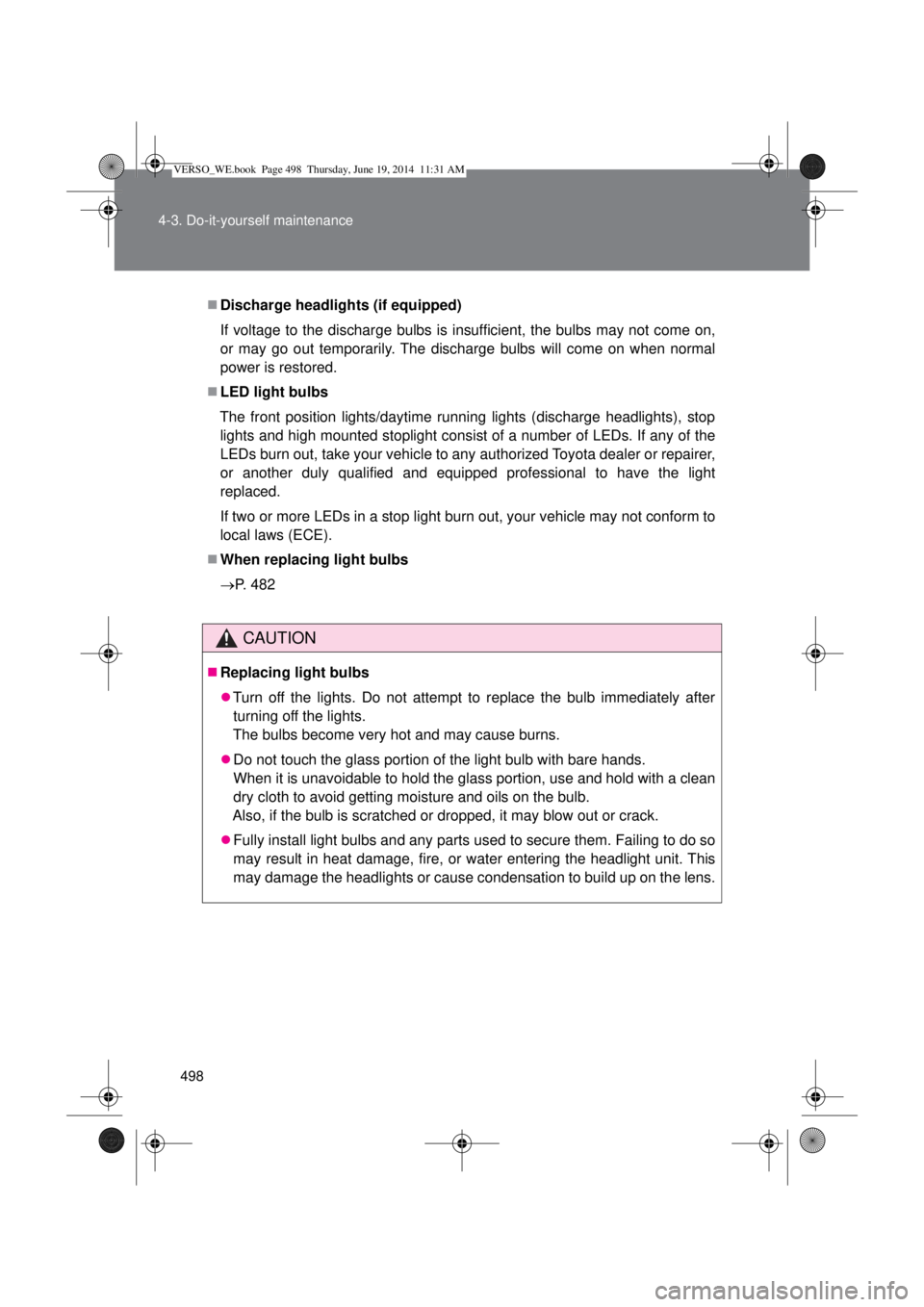Page 497 of 650

497 4-3. Do-it-yourself maintenance
4
Maintenance and care
When replacing the following bulbs:
Headlight (halogen headlights)
Front position light (halogen headlights without daytime running light sys-
tem)
Front position light/daytime running light (halogen headlights with day-
time running light system)
Front turn signal light
Replacing the air cleaner duct and/or washer fluid filler opening.
Left side
Right side
Replacing the engine compartment cover. (P. 423)
Condensation build-up on the inside of the lens
Temporary condensation build-up on the inside of the headlight lens does
not indicate a malfunction.
Contact any authorized Toyota dealer or repairer, or another duly qualified
and equipped professional, for more information in the following situations:
Large drops of water are built up on the inside of the lens.
Water has built up inside the headlight.
After replacing the bulbs, make sure to
secure the upper part of the air cleaner
duct with the clip.
After replacing the bulbs, make sure to
secure the washer fluid filler opening with
the clip.
VERSO_WE.book Page 497 Thursday, June 19, 2014 11:31 AM
Page 498 of 650

498 4-3. Do-it-yourself maintenance
Discharge headlights (if equipped)
If voltage to the discharge bulbs is insufficient, the bulbs may not come on,
or may go out temporarily. The discharge bulbs will come on when normal
power is restored.
LED light bulbs
The front position lights/daytime running lights (discharge headlights), stop
lights and high mounted stoplight consist of a number of LEDs. If any of the
LEDs burn out, take your vehicle to any authorized Toyota dealer or repairer,
or another duly qualified and equipped professional to have the light
replaced.
If two or more LEDs in a stop light burn out, your vehicle may not conform to
local laws (ECE).
When replacing light bulbs
P. 482
CAUTION
Replacing light bulbs
Turn off the lights. Do not attempt to replace the bulb immediately after
turning off the lights.
The bulbs become very hot and may cause burns.
Do not touch the glass portion of the light bulb with bare hands.
When it is unavoidable to hold the glass portion, use and hold with a clean
dry cloth to avoid getting moisture and oils on the bulb.
Also, if the bulb is scratched or dropped, it may blow out or crack.
Fully install light bulbs and any parts used to secure them. Failing to do so
may result in heat damage, fire, or water entering the headlight unit. This
may damage the headlights or cause condensation to build up on the lens.
VERSO_WE.book Page 498 Thursday, June 19, 2014 11:31 AM
Page 504 of 650
504 5-1. Essential information
Emergency towing
If a tow truck is not available in an emergency, your vehicle may be
temporarily towed using a cable or chain secured to the emergency
towing eyelet. This should only be attempted on hard, surfaced roads
for short distances at low speeds.
A driver must be in the vehicle to steer and operate the brakes. The
vehicle’s wheels, drive train, axles, steering and brakes must be in
good condition.
Towing eyelet
Emergency towing procedure
Vehicles without smart entry & start system
Release the parking brake.
Put the shift lever in “N”.
Turn the engine switch in the “ACC” (engine off) or “ON” position
(engine running).
Vehicles with smart entry & start system
Release the parking brake.
Pull the shift lever in “N”.
The “ENGINE START STOP” switch must be in ACCESSORY
mode (engine off) or IGNITION ON mode (engine running).
VERSO_WE.book Page 504 Thursday, June 19, 2014 11:31 AM
Page 506 of 650
506 5-1. Essential information
Installing towing eyelet
Remove the eyelet cover using a
flathead screwdriver.
To protect the bodywork, place a
rag between the screwdriver and
the vehicle body, as shown in the
illustration.
Insert the towing eyelet into the
hole and tighten partially by
hand.
Tighten down the towing eyelet
securely using a wheel nut
wrench
* or hard metal bar.
*: If a wheel nut wrench is not
equipped, a wheel nut wrench
can be purchased at any autho-
rized Toyota dealer or repairer, or
another duly qualified and
equipped professional.
Location of the emergency towing eyelet
P. 536, 552
VERSO_WE.book Page 506 Thursday, June 19, 2014 11:31 AM
Page 507 of 650
5
507 5-1. Essential information
When trouble arises
Towing with a sling-type truck
CAUTION
Installing towing eyelet to the vehicle
Make sure that towing eyelet is installed securely. If not securely installed,
towing eyelet may come loose during towing. This may lead to accidents that
cause serious injury or even death.
NOTICE
To prevent body damage
Do not tow with a sling-type truck, either from the front or rear.
VERSO_WE.book Page 507 Thursday, June 19, 2014 11:31 AM
Page 511 of 650
5
511 5-1. Essential information
When trouble arises
Using a flat bed truck
If your Toyota is transported by a
flat bed truck, it should be tied
down at the locations shown in
the illustration.
When using a chain or strap to
tie down the rear of the vehicle,
secure it at a 45 angle as shown
in the illustration.
Do not overly tighten the tie
downs or the vehicle may be
damaged.
Front
VERSO_WE.book Page 511 Thursday, June 19, 2014 11:31 AM
Page 539 of 650
5
539 5-2. Steps to take in an emergency
When trouble arises
Taking out the spare tire (vehicles without the third seat)
Open the rear deck board.
Vehicles with a standard spare tire
Vehicles with a compact spare tire
Secure the rear deck board,
using the strap hook provided.
Remove the strap hook
Secure the hook
VERSO_WE.book Page 539 Thursday, June 19, 2014 11:31 AM
Page 540 of 650
540 5-2. Steps to take in an emergency
Remove the cover.
Loosen the center fastener that
secures the spare tire.
Take out the spare tire.
Vehicles with a standard spare tire
VERSO_WE.book Page 540 Thursday, June 19, 2014 11:31 AM